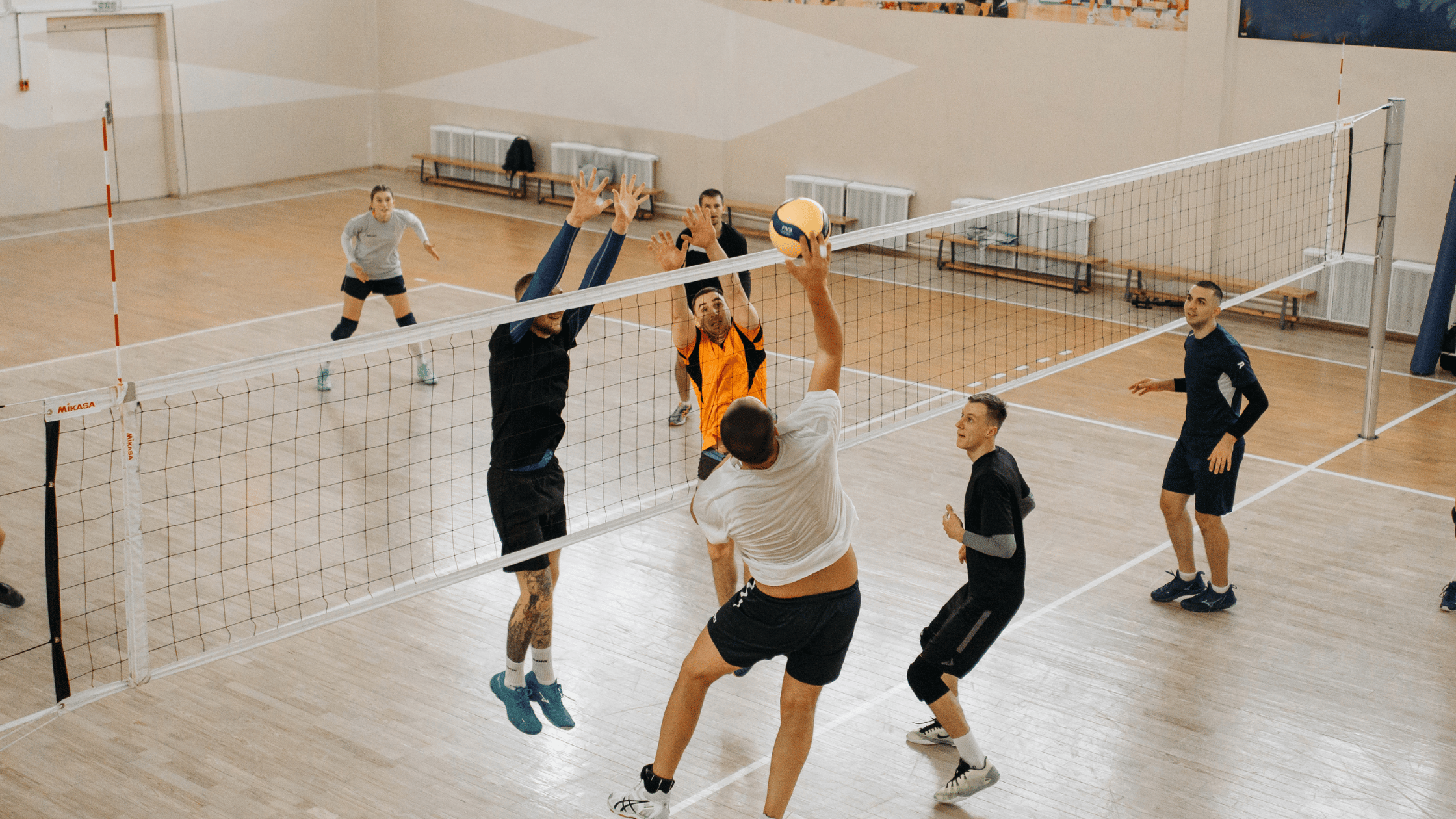Beginner’s Guide to Volleyball as a Hobby: Essential Tips and Insights
Looking to pick up a fun and engaging hobby? Volleyball might just be the perfect choice for you.
Whether you hit the court for a casual game with friends or dive deeper into competitive play, volleyball offers an exciting mix of action, strategy, and social bonding.
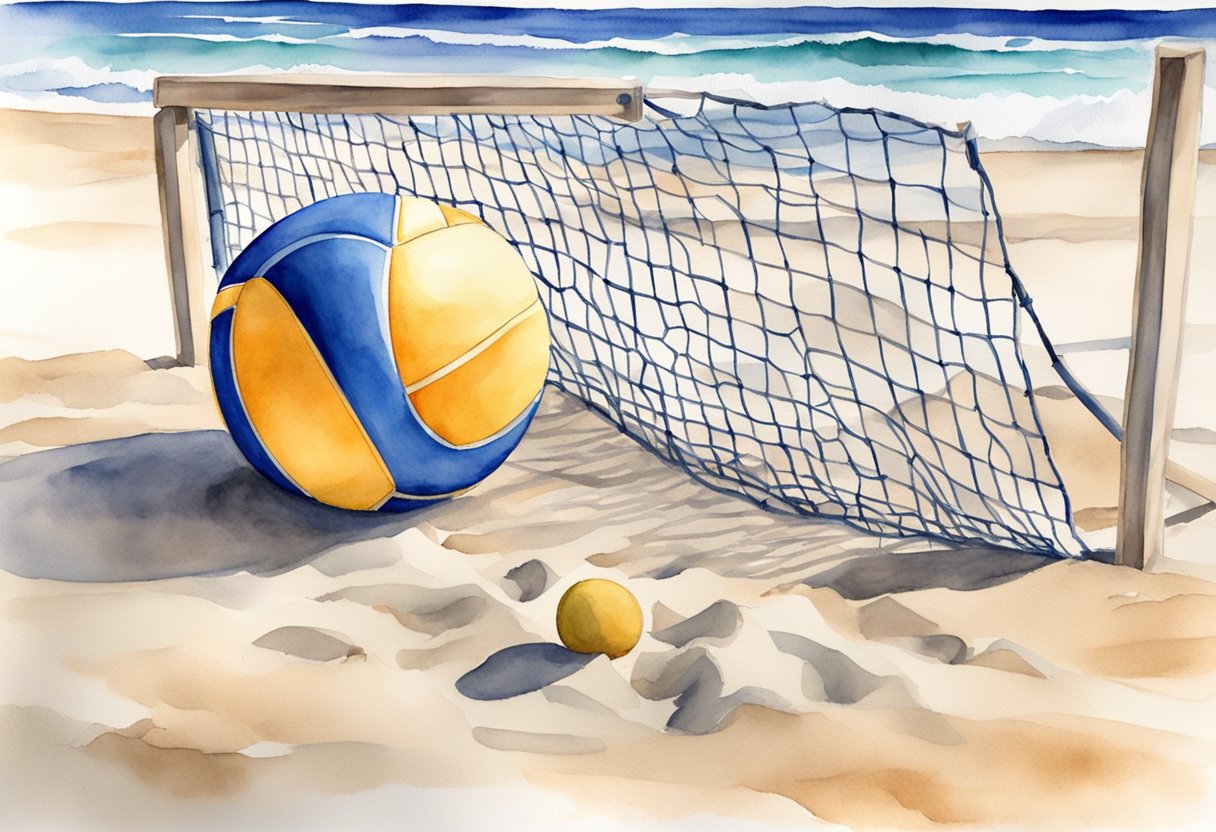
Volleyball is a dynamic game that enhances both physical fitness and mental agility. From mastering foundational skills like setting and spiking to understanding the rules and gameplay, this sport can become both a passion and a great way to stay active.
You will develop agility, coordination, and teamwork, all while having fun on the court.
Getting started is simple, making it an ideal sport for beginners eager to master new skills.
As you embark on this journey, you will find various forms of play, from beach volleyball to indoor leagues. Each type offers unique challenges and benefits, encouraging you to expand your skills. Remember, the main aim is to enjoy yourself, whether you’re diving for the ball or encouraging your teammates.
Key Takeaways
- Volleyball is an exciting and accessible hobby for beginners.
- Mastering basic skills and understanding gameplay are key.
- The sport offers fun and fitness benefits while building team dynamics.
Understanding the Basics
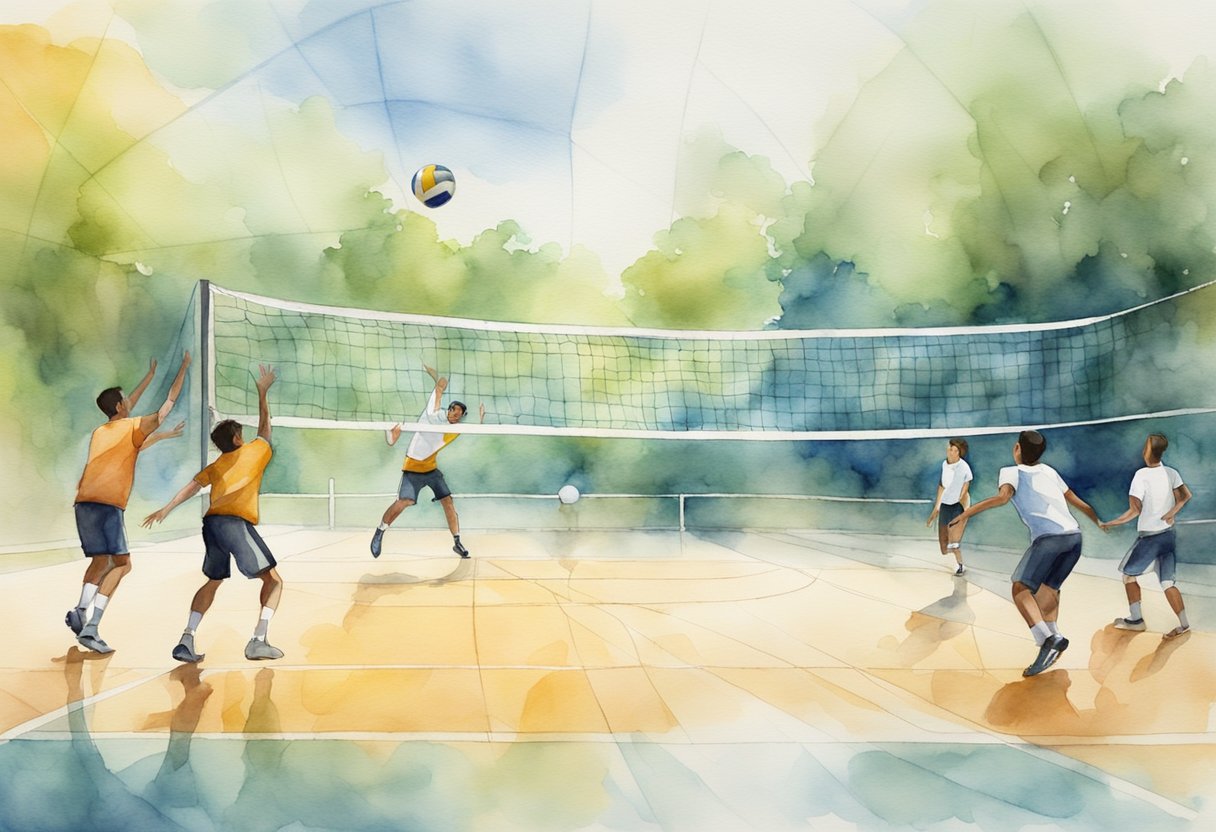
Volleyball is an engaging team sport played on a court with specific equipment and player positions. To excel in this sport, it’s important to have a clear grasp of the court layout, the essential gear required, and the different roles players assume during the game.
The Volleyball Court
The volleyball court is rectangular, measuring 18 meters long and 9 meters wide.
Divided by a central net, the court has two equal halves where teams compete. Each side is further divided into front and back zones, crucial for player positioning during play.
The net height differs based on the type of game played. For men’s competitions, the net is set at approximately 2.43 meters, while for women, it’s roughly 2.24 meters.
The service area is found behind the end line, where the server stands to initiate play. Boundary lines mark the court’s perimeter, helping to determine in-bounds and out-of-bounds plays, essential for accurate scoring.
Essential Volleyball Equipment
To play volleyball, you need a few key pieces of equipment.
The volleyball itself should be spherical and made from leather or synthetic leather, weighing between 260 to 280 grams and with a circumference of about 65-67 cm. This ensures consistent play and durability.
The net is another critical component. It must be securely anchored and evenly tensioned to maintain fairness in gameplay.
Additionally, players should wear proper athletic gear for comfort and safety, including non-slip court shoes, knee pads for protection, and breathable jerseys.
This basic equipment helps provide the necessary support for effective and enjoyable gameplay.
Player Positions and Roles
On the court, six players per team are categorized into specific roles: outside hitter, opposite hitter, setter, middle blocker, libero, and defensive specialist. Each position plays a distinct part in both offense and defense.
Outside hitters often spike from the front and back rows.
Opposite hitters provide support opposite the setter, often as additional attackers.
The setter orchestrates the offense by setting up attackers.
Middle blockers are key in blocking attacks from the opposing team and executing quick attacks.
The libero is a defensive specialist, focusing on receiving serves and digging attacks, wearing a different colored jersey for easy identification.
Understanding these roles is crucial for effective team strategy and gameplay execution.
Fundamental Skills for Beginners
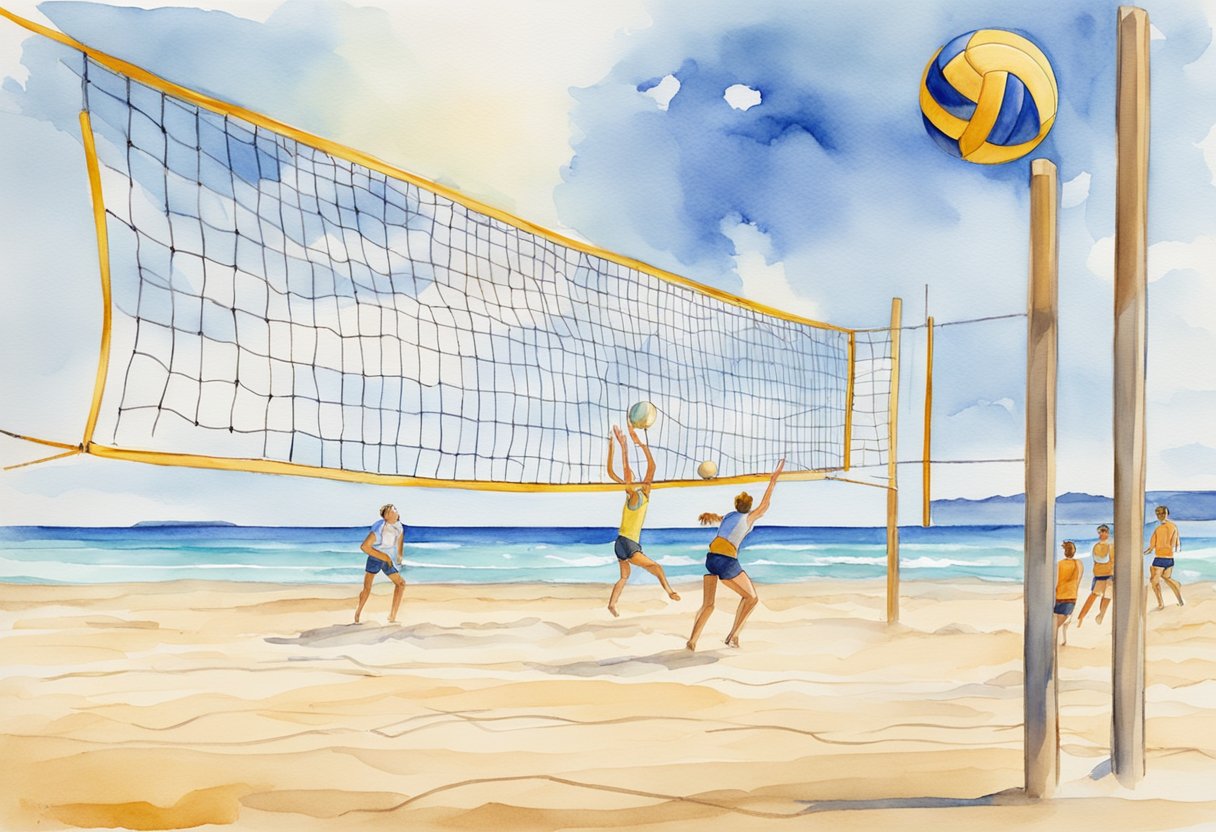
Developing core skills like passing, setting, hitting, and serving will provide a solid foundation for anyone starting out in volleyball. Each skill plays a crucial role in gameplay, contributing to both individual performance and team success.
Passing
Passing, often referred to as digging, is essential for a strong defense. Your primary goal is to control the ball and accurately direct it back into play.
Focus on maintaining a low stance with your knees bent, arms extended, and hands together to create a stable platform.
Anticipation is key, as reading the ball’s trajectory allows you to position yourself effectively.
Practicing footwork drills will help improve your agility and response time. You’ll want to develop a consistent passing technique to ensure your team can build successful plays from your passes.
Setting
Setting is vital for preparing an attack. This skill requires precision and timing to deliver the ball to teammates for an effective spike.
Use your fingertips rather than your palms and position yourself underneath the ball for better control.
A good setter must be aware of the positions of all players, making strategic decisions on whom to pass the ball.
Developing quick reflexes and decision-making skills will enhance your setting ability.
Practice receiving balls from different angles to improve your technique and adaptability.
Hitting
Hitting, or spiking, is your main offensive weapon. It involves powerful and well-placed strikes to score points.
Focus on your approach, which typically starts with a quick two or three-step run-up. Timing is important, so jump at the right moment to maximize power.
Practice your arm swing to ensure fluid motion and impact.
Versatility in your hitting techniques can make you more unpredictable to the opposition.
Working on both cross-court and down-the-line hits will expand your offensive options and increase your attacking effectiveness.
Serving
Serving initiates each rally and can set the tone for the match. A well-executed serve can disrupt the opposing team’s formation and create scoring opportunities.
Learn different serving techniques, such as overhand or jump serves, to find what suits you best.
Focus on accuracy and consistency rather than force.
A good serve lands close to the opponent’s baseline, making it difficult to return.
Pay attention to your toss, as a consistent toss leads to a more reliable serve.
Practicing various serves will increase your effectiveness and adaptability in matches.
Rules and Gameplay
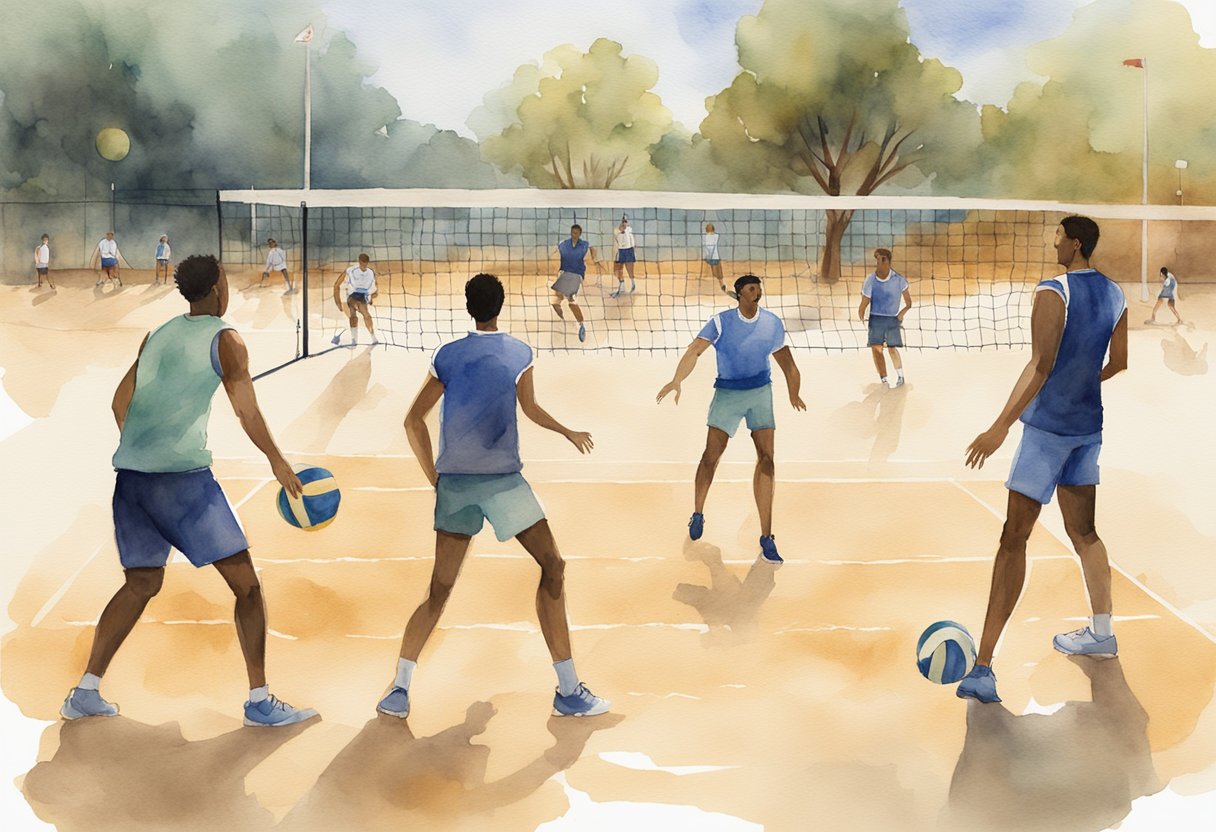
In volleyball, understanding both the basics of the sport’s rules and implementing effective gameplay strategies is crucial for newcomers.
You’ll need to familiarize yourself with the court layout, player positions, and game progression.
Basic Volleyball Rules
In volleyball, each team consists of six players on the court. The objective is to send the volleyball over the net to land in the opposing team’s court.
Matches are played in sets, usually best of five, with each set going to 25 points while requiring a two-point lead to win.
When serving, players must ensure the ball does not touch the net or land outside the opponent’s court.
A team is allowed a maximum of three successive contacts of the ball to return it across the net, which involves a sequence typically called bump, set, and spike.
The first touch, or bump, prepares the ball, followed by a set to position it, leading to a spike to drive the ball into the opposing court forcefully.
Rotation occurs after each service win, shifting players clockwise.
How to Start Playing
To begin your journey with volleyball, you can either join a local team or club or gather friends for casual matches.
Engaging in practice sessions will help you grasp the essential skills and rules more rapidly.
Start by learning basic techniques like serving, setting, and spiking.
Watching matches or tutorials can offer practical insights into proper form and strategies.
Participating in drills can be beneficial in honing specific skills such as passing accuracy, defensive maneuvers, and offensive plays.
Consider joining a volleyball league to experience structured competition and teamwork, which is recommended for learning player rotations and on-court communication.
Staying disciplined with practice will improve your gameplay and understanding of match strategies over time.
Building Team Dynamics
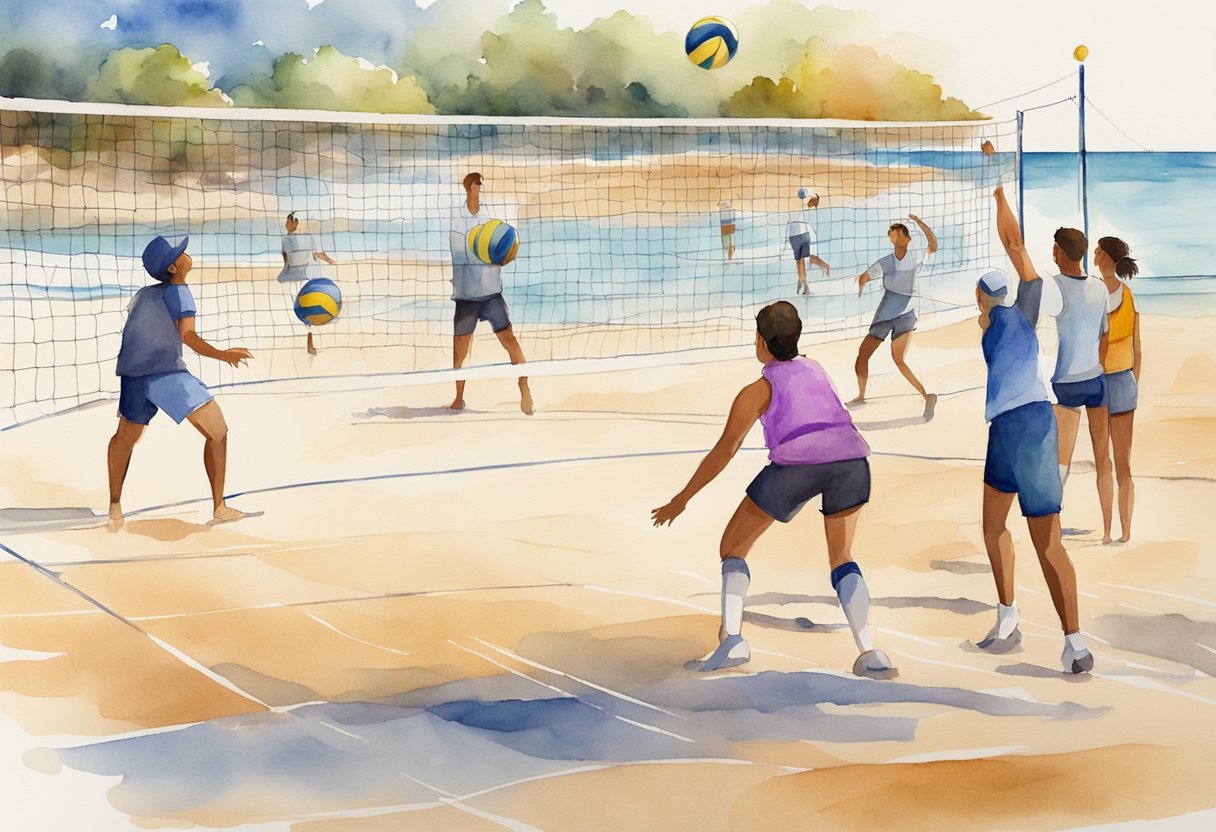
In volleyball, effective teamwork and strong trust among team members are essential for success. Fostering these dynamics requires constant effort and commitment.
Teamwork and Communication
Clear communication on the court is crucial for maintaining a smooth flow during games.
Use short, loud commands to inform teammates of your actions, like calling “mine” or announcing the type of play you’re setting up. This reduces the chance of confusion and helps the team function as a unit.
Regular team-building drills can also enhance teamwork in 6v6 play.
These drills help players anticipate each other’s moves, improving coordination.
Small-sided games that focus on specific skills or objectives can sharpen these abilities further, leading to better in-game performance and stronger team cohesion.
Trust Among Team Members
Trust forms the foundation of any successful volleyball team.
During off-court activities, such as team outings or bonding exercises, you can build deeper personal connections with your teammates.
These interactions contribute to stronger interpersonal trust, enhancing communication and cooperation during matches.
Participating in team bonding activities helps foster mutual respect and understanding among players, which translates to more effective collaboration on the court.
By trusting one another’s decisions in high-pressure situations, your team can maintain a positive atmosphere and resilience, even when facing tough opponents.
Training and Development
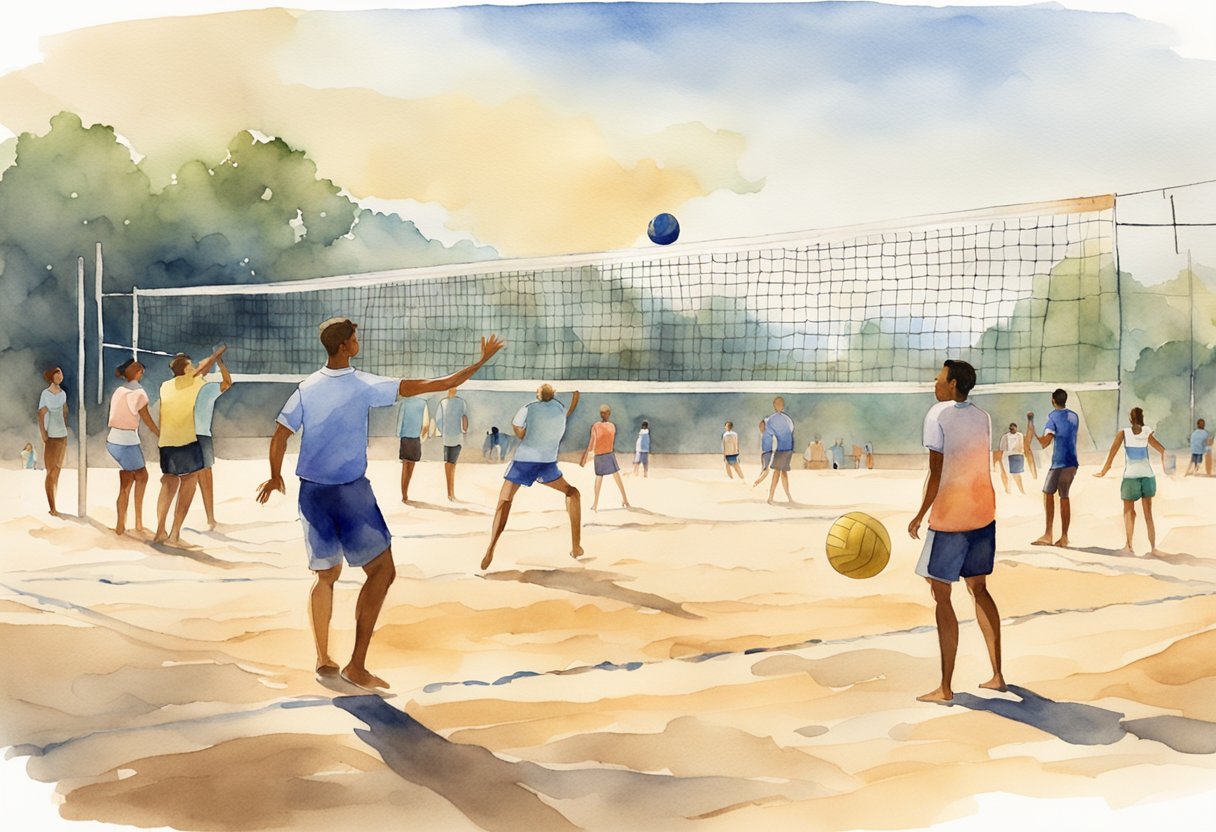
To excel in volleyball, focus on enhancing your skills through targeted practice. This involves drills to boost your technique, exercises to improve agility and coordination, and routines to increase your physical fitness. Understanding these elements helps you become a more effective player on the court.
Practice Drills
Regular practice drills are crucial for honing your volleyball skills.
Focus on bumping, setting, and spiking, which are fundamental techniques.
Consider setting a regular schedule for practice that includes drills like passing to a wall to improve control and accuracy.
Incorporate partner drills where you can practice sets and spikes, gaining real-time feedback on your technique.
Make sure you dedicate time to serving drills, as serves are a critical aspect of the game.
Using markers on the court to target specific zones can enhance precision and tactic variety.
Improving Coordination and Agility
Agility and coordination are key components in volleyball, allowing you to react quickly and efficiently.
Start with ladder drills to improve foot speed and coordination.
Agility cones are useful for practicing direction-changing movements, simulating real-game scenarios.
Balance exercises, like single-leg stands, help enhance your spatial awareness and control.
Incorporating dynamic stretching routines before and after exercises can maintain your flexibility and reduce injury risk.
Practicing shadow movements without the ball can also improve your anticipation and reaction time on the court.
Enhancing Physical Fitness
Improving your physical fitness directly impacts your performance in volleyball.
Prioritize cardiovascular exercises such as jogging or cycling to build endurance.
Strength training, focusing on your legs and core, can enhance your jumping ability and overall power.
Incorporate interval training to improve your speed and stamina, essential for quick bursts of activity in matches.
Combining circuit training with bodyweight exercises like push-ups and squats can increase muscular endurance.
Remember to integrate rest days into your routine to allow muscle recovery and prevent burnout.
Types of Volleyball Play
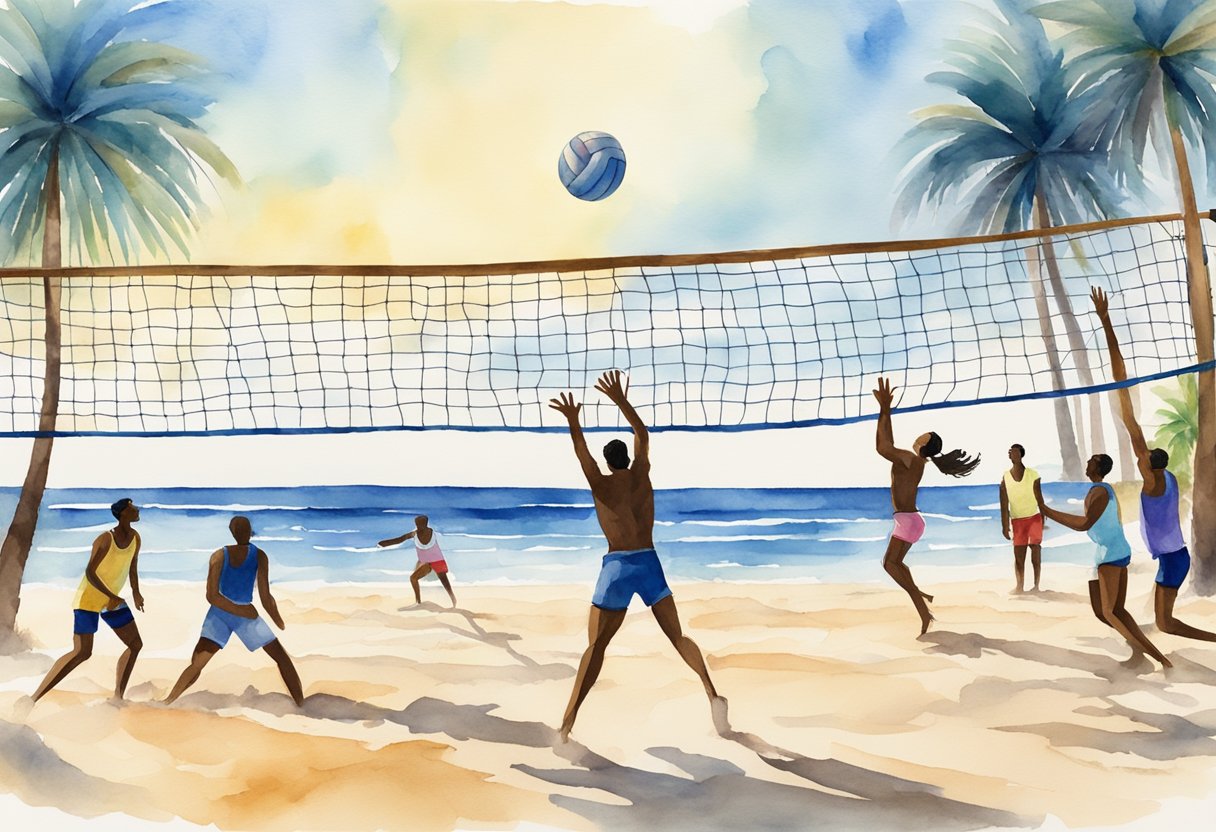
Different types of volleyball can be played depending on your preferences and environment.
From the sun-soaked sands of the beach to the buzz of indoor sports halls, each type of play offers unique experiences and challenges.
Beach Volleyball
Beach volleyball is played on sand with teams of two players. It is known for its relaxed vibe and distinct rules compared to indoor volleyball.
The sand affects movement, making matches physically demanding. You’ll need power and agility to spike and defend effectively.
Beach courts are smaller, and the game employs a softer ball with a slower speed. This emphasizes player skill and strategy, often requiring precise ball control.
Beach volleyball has grown significantly in popularity, with its inclusion in the Olympic Games showcasing its global appeal.
Indoor Volleyball
Indoor volleyball is typically played with teams of six players on each side. This version requires excellent teamwork and communication.
Matches are fast-paced with strong emphasis on tactical play and strategic positioning. The hard court allows for more precise movement and powerful plays.
The court design includes a front and back row, which adds complexity to defensive and offensive strategies.
You’ll find indoor volleyball common in schools and recreational leagues, making it a highly accessible option for beginners and seasoned players alike.
Sitting Volleyball
Sitting volleyball is a variation designed to be inclusive, enabling people with and without disabilities to participate.
Played on a smaller court with a lower net, each team has six players seated on the floor. The rules are similar to standard volleyball, but the physical demands differ.
Quick reflexes and teamwork are crucial for success given the limited mobility. This version offers a great way to engage with volleyball’s competitive spirit while fostering inclusivity.
Sitting volleyball has gained recognition as a Paralympic sport, promoting its accessibility and appeal across different skill levels.
Advancing Your Skills
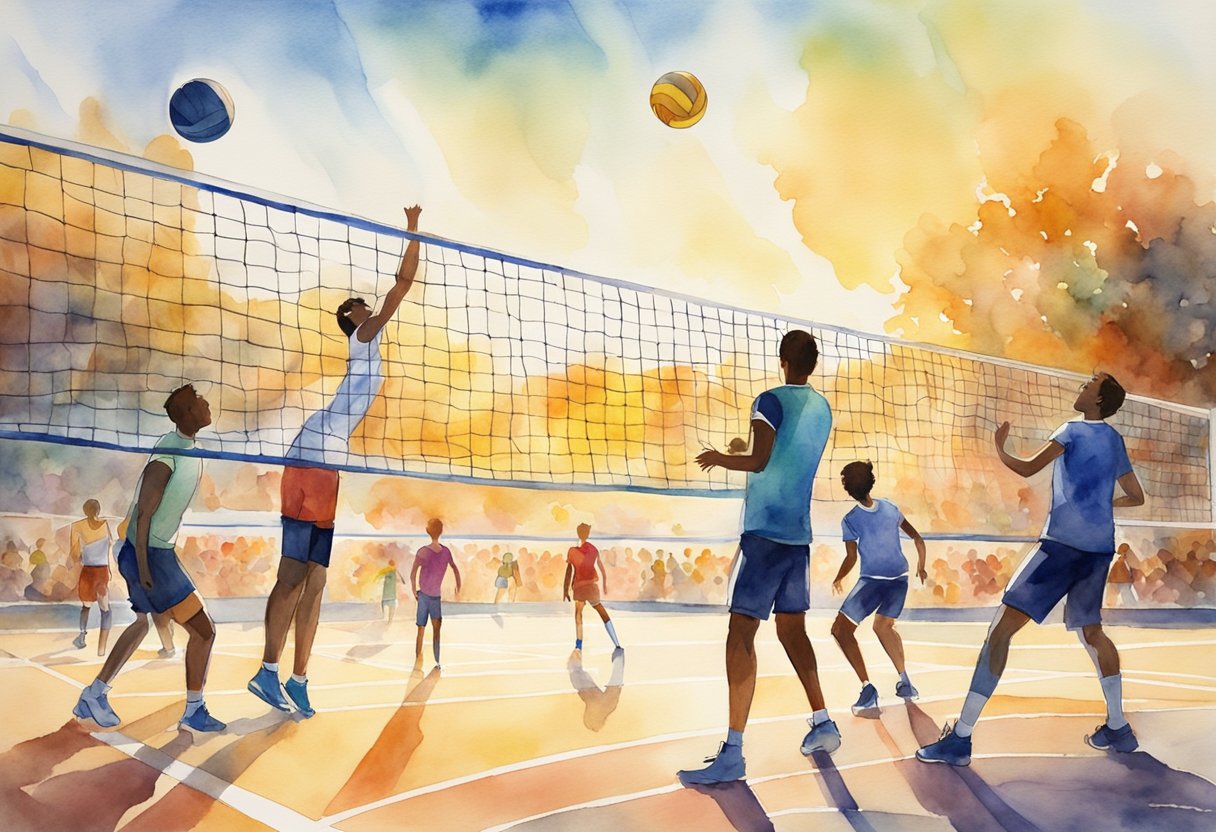
To enhance your volleyball abilities, focus on improving techniques such as spiking and understanding both offensive and defensive strategies.
These core areas are key to elevating your game.
Mastering Spiking
Spiking is a crucial skill that demands power and precision.
Begin by refining your approach to the ball and your jump technique. Timing is everything; you need to meet the ball at its peak with your hand.
Practice your wrist snap during ball contact to control the direction and speed of the spike.
Use drills to perfect your spiking, such as wall spiking, where you aim for a specific point on the wall to increase accuracy.
Include strength training in your routine to enhance your jumping ability and arm speed. Incorporating exercises that build core strength and agility can significantly improve your overall performance in this area.
Understanding Offensive and Defensive Strategies
Grasping both offensive and defensive strategies is vital for a well-rounded game.
Offensively, focus on positioning to optimize attack opportunities. Work with your setter to develop seamless plays that catch the opposition off-guard.
Practice quick transitions from defense to offense to gain a strategic edge.
On defense, hone skills such as blocking and reading the opposing team’s hitters. Stay alert and adjust your positioning according to the attackers.
Develop communication with your teammates to ensure proper coverage and support on the court.
Regular drills and match simulations will help reinforce these strategies and make you a versatile player.
Safety and Injury Prevention

Ensuring safety in volleyball requires understanding proper techniques and using the right equipment. To minimize injuries, consider these essential tips.
Protective Gear: Invest in good quality knee pads to cushion impacts and prevent bruises or scratches when diving or sliding on the court. Knee pads provide crucial protection during intense matches.
Footwear: Choosing the right volleyball shoes is vital. These shoes offer better grip, stability, and cushioning.
Proper footwear helps prevent ankle sprains and enhances your performance by providing the support needed for jumps and quick movements.
Warm-Up and Conditioning: A proper warm-up routine is essential. Incorporate dynamic stretches and exercises to prepare your muscles and joints.
Conditioning helps improve your fitness level, reducing the risk of overuse injuries such as tendinitis or bursitis.
Technique and Skill Development: Focus on learning correct techniques for spiking, serving, and blocking. Incorrect movements can lead to injuries.
Seek guidance from experienced coaches or online resources to improve your skills safely.
Injury Prevention Training: Incorporate specific exercises into your routine to strengthen the muscles used in volleyball.
Programs like those suggested by experts offer structured training approaches. For more details, check out strategies for injury prevention.
Joining the Volleyball Community
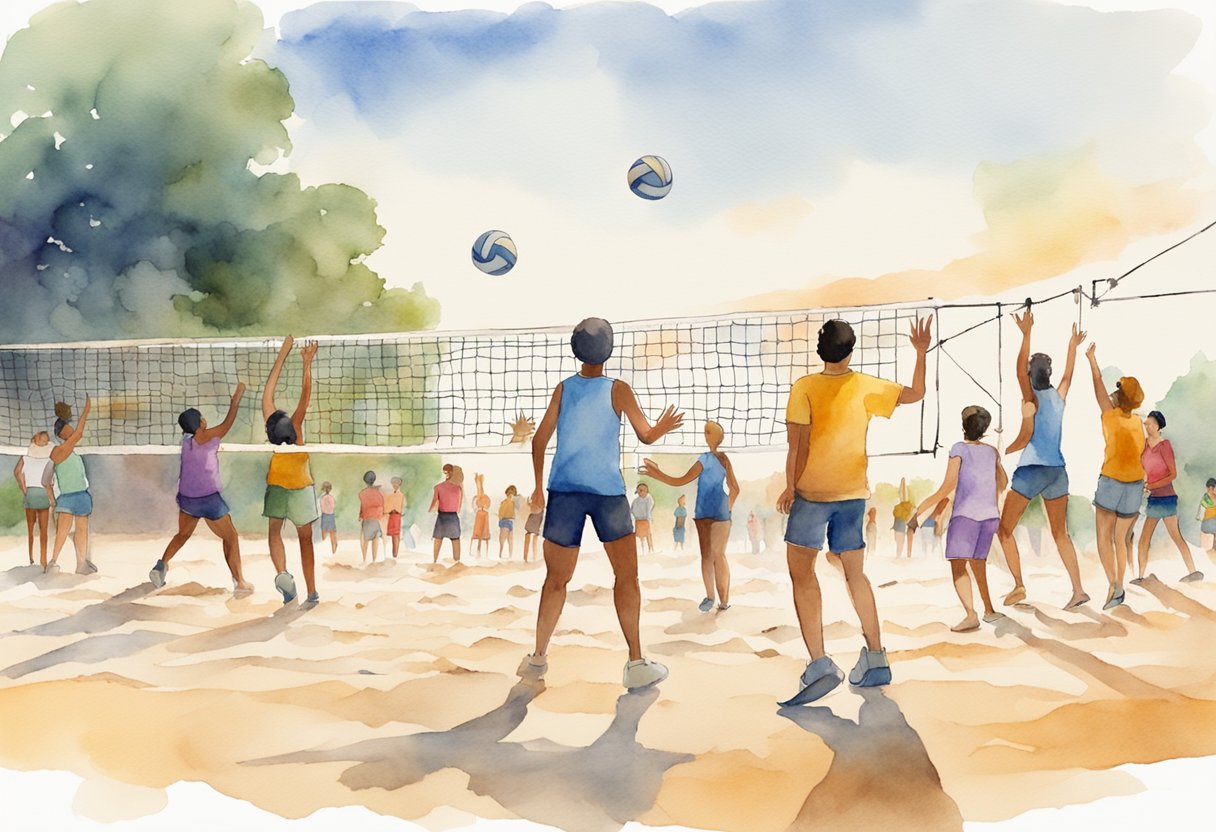
Engaging in volleyball as a hobby can be greatly enriched by becoming part of a community. Meeting other players and participating in events provides an opportunity to enhance your skills and enjoy the social side of the sport.
Finding Local Teams and Leagues
To get started, search for local volleyball clubs or community centers that host teams and leagues.
These organizations often list details about matches and practice sessions on their websites or social media pages.
Joining a team requires understanding the game rules, so familiarize yourself with basic techniques like bumping, setting, and spiking.
Participating in local leagues helps improve your game significantly. You can learn from experienced players and coaches, making it a valuable part of your volleyball journey.
Additionally, regular practice in a team setting offers more competition experience and enhances your skills quickly.
Volleyball Social Events
Volleyball is not just about the game; it’s also a social experience. Many clubs and organizations arrange social events, tournaments, and informal games.
These gatherings provide an excellent platform for meeting new people and engaging in friendly competition.
Events such as mixers or friendly matches help you connect with people who are equally enthusiastic about the sport.
By participating in these activities, you enhance your social interaction with fellow players.
This creates lasting connections and elevates your enjoyment of volleyball beyond just playing matches. Social gatherings are essential in fostering a sense of community and camaraderie among players.
Benefits of Volleyball
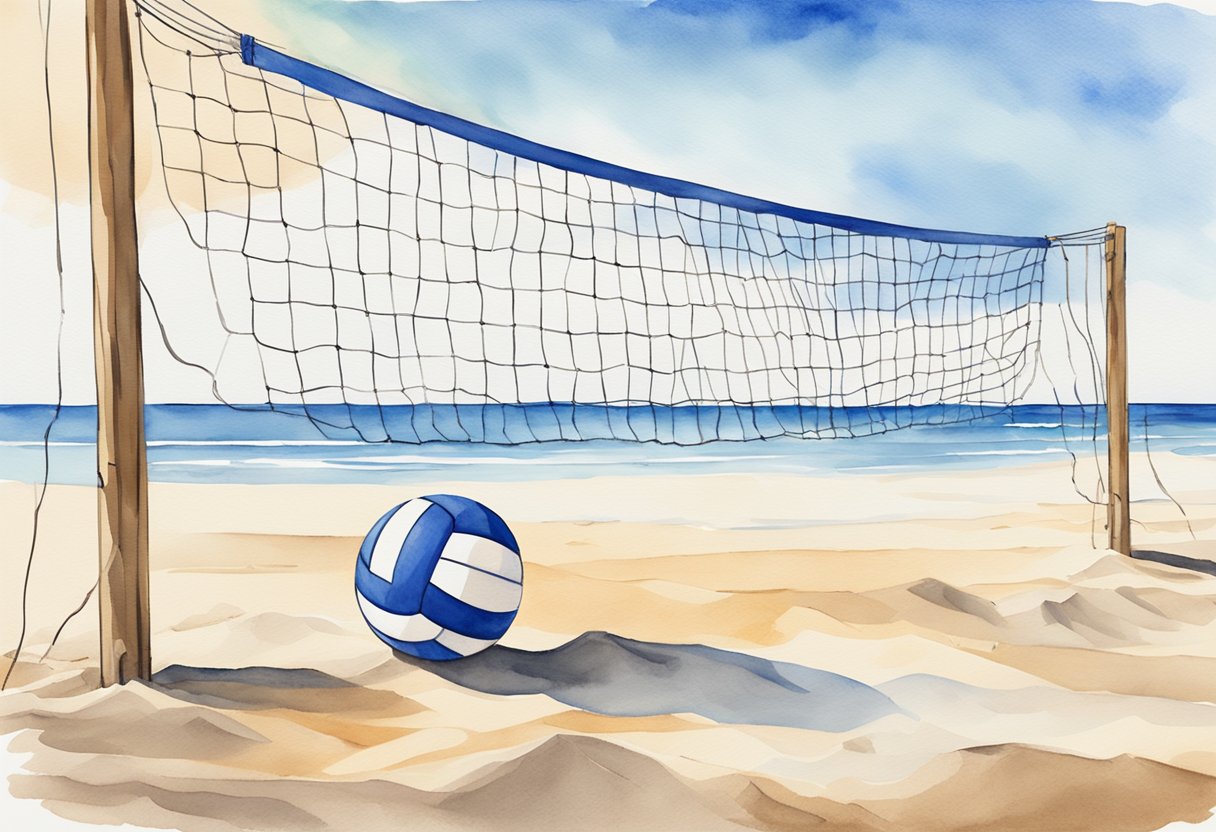
Playing volleyball offers various physical and mental advantages. Regular participation in the sport enhances agility, coordination, and cardiovascular fitness. As you engage in the activities involved, you’ll notice improvements in your body’s ability to move quickly and efficiently.
Another key benefit is stress reduction. Physical activity in volleyball helps release endorphins, which are natural mood lifters. This contributes to a feeling of well-being and can significantly boost your mood.
Volleyball is more than just a physical game; it’s also a social sport. Engaging with teammates fosters teamwork and communication skills.
Playing with others also provides opportunities to build lasting friendships and bonds.
An important aspect of volleyball is its character-building ability. Skills such as leadership and respect are essential during gameplay and can translate into everyday life.
This makes volleyball an excellent choice for personal development.
You don’t need to be an expert to enjoy the sport. Starting volleyball as a hobby allows you to gradually improve your skills, making it accessible to beginners. It’s an inclusive activity welcoming players of all skill levels and ages.
Incorporating volleyball into your routine can positively influence your physical health and enhance your social interactions and personal growth. This sport encourages an active lifestyle that promotes overall fitness and well-being.
Frequently Asked Questions
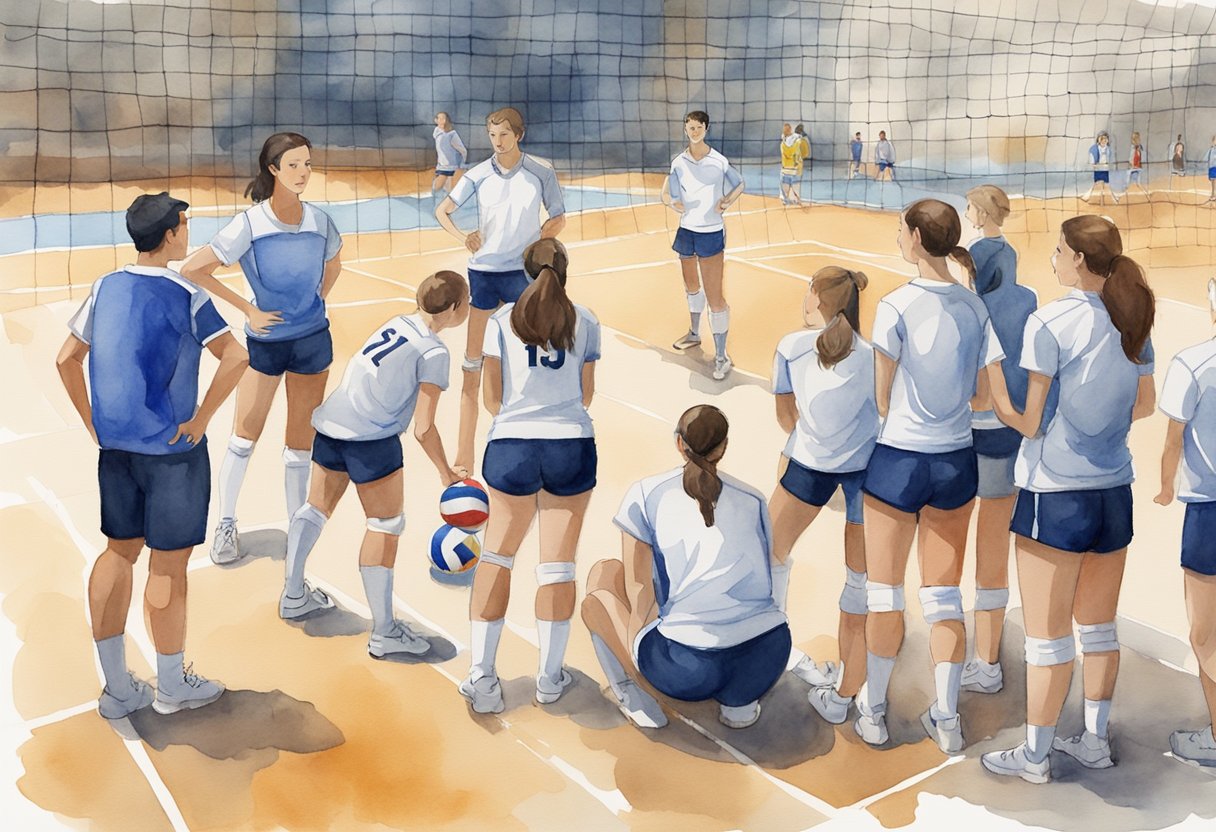
Starting volleyball requires some basic equipment, skills, and knowledge of the game rules. Engaging with local clubs and practicing effective techniques are essential steps for beginners.
What equipment do I need to start playing volleyball?
To begin playing volleyball, you’ll need a quality volleyball, which is roughly 25.5 to 26.5 inches in circumference, and comfortable sportswear.
Ensure you have good supportive shoes for indoor courts and possibly a pair of knee pads to prevent injuries from dives and falls.
What basic skills should I learn first as a volleyball beginner?
As a beginner, focus on learning the fundamental skills such as bumping, setting, and spiking. These techniques are vital for successfully returning the ball over the net.
Practicing these skills will enhance your ability to control the ball during a game.
How do I find local volleyball teams or clubs suitable for beginners?
Look for local community centers or sports clubs that offer volleyball programs.
Online platforms and social media groups often provide information about beginner-friendly volleyball teams.
Joining a club can help you meet others with similar interests and improve your skills through regular play.
What are the key rules I should know before playing my first game?
Understand that each team has six players and each side is allowed a maximum of three hits to return the ball. Players rotate positions after winning a serve.
Familiarize yourself with the rules around scoring, such as teams earn points when the opposing team fails to return the ball legally or hits it out of bounds.
How often should I practice volleyball when starting out?
Begin with practicing at least two to three times a week. Consistency is key to improving your skills and building muscle memory.
Over time, as you become more comfortable, you can increase your practice frequency to further enhance your proficiency in the sport.
What are some effective serving techniques for new volleyball players?
For beginners, the underhand serve is the easiest to learn. Focus on mastering this before progressing to overhand serves.
Practicing accurate serving helps build confidence and is critical for initiating play during matches. Consider joining a class or seeking coaching to refine these techniques.

